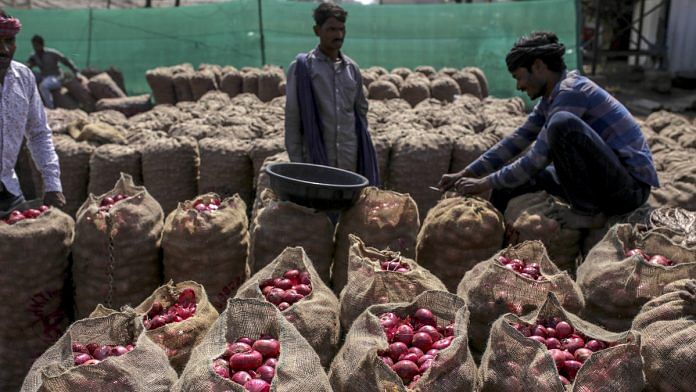New Delhi: The soaring retail prices of onion are set to witness a substantial dip in the New Year with the arrival of fresh imports that will coincide with the domestic supply of new produce from the rabi (winter) and late kharif (summer) seasons — thereby also giving rise to the possibility of a glut.
Sources in the consumer affairs ministry told ThePrint the arrival of imported onions will coincide with the supply of late kharif onions from Maharashtra and Gujarat in the last week of December, as well as the early rabi produce from Rajasthan, Madhya Pradesh and Karnataka by late January.
“This could lead to the prices of onion crashing and glut in the market,” said a ministry official.
According to agriculture ministry’s data, 0.98 lakh hectare area is covered under late kharif as against 1.22 lakh hectare in the corresponding period last year. The area under rabi onion crop, meanwhile, is 2.76 lakh hectare as against 2.31 lakh hectare in the corresponding period last year (until the first week of December this year).
This, ministry sources said, basically indicates that there has been an increase in sowing by onion farmers in the hope of getting a better return for their produce.
“However, with the stock limit in place and arrival of major consignments of imported onions in the country, it’s quite likely that the price of onions is going to crash or even lead to a glut in coming months,” said another ministry official.
In Maharashtra, the late kharif crop supply has already started to enter the markets, resulting in onion prices deflating in mandis across the state.
The average wholesale onion price at Lasalgaon APMC (agricultural produce market committee) dropped by around Rs 1,500/quintal to Rs 7,100/quintal from an all-time high of Rs 8,625/quintal last Monday.
“The daily supply of onions in the mandi was hovering around 6,000-8,000 quintal for the last few months. This has now increased to 10,000-12,000 quintal since last Wednesday,” director of NAFED at Lasalgaon APMC Nana Saheb Patil told ThePrint.
“The increase in onion supply is due to the late kharif onions from Solapur, Dhule and Pune. However, the price is expected to stabilise by mid-February and March (next year) when the wholesale rate in mandi will reach around Rs 3,000 to Rs 2,000 per quintal,” he added.
As far as early rabi produce is concerned, they will start coming from Karnataka’s Dharwad, Haveri, Bagalkot and Davangere regions.
“The prices have already come down to Rs 13,000 per quintal from Rs 16,000 per quintal in the first week of December,” NAFED director of Karnataka State Cooperative Marketing Federation Patangay Jayavanth Rao told ThePrint.
Also read: This is how India can make sure onions are available throughout the year and at good price
Prices to come down in several states
Madhya Pradesh has also seen an increase in the supply of onions as late kharif and early rabi crops are coming in from onion-growing western parts of the state like Sagar, Khandwa, Dewas, Ratlam, Dhar, Satna, Khargone and Chhindwara.
On 18 December, 7,500 bags of onions were auctioned, compared to 5,000 last week. The prices in mandis have already decreased, with onions selling between Rs 3,000 and Rs 8,000 per quintal on 18 December as against Rs 5,000 and Rs 11,000 per quintal the previous week.
The new supply of onions from Maharashtra, Madhya Pradesh and Gujarat are expected to decrease prices in markets of Jaipur, Lucknow and Delhi, from where they are distributed in states/union territories like Himachal Pradesh, Uttarakhand, Jammu and Kashmir, Punjab and Haryana.
Onions from Karnataka and Andhra Pradesh are mostly consumed in southern states.
Govt’s earlier measures to control price rise
After prices of the key kitchen staple started to soar from mid-October — hovering between Rs 80/kg and Rs 100/kg — the central government stepped in to control the price rise — via imports.
On 20 November, Union Finance Minister Nirmala Sitharaman announced the government has decided to import 1.2 lakh metric tonnes (MT) of onion. The government also announced a slew of measures, including banning exports, imposing a stock limit and relaxing phytosanitary and fumigation norms, to tackle the soaring prices.
But dilly-dallying on the part of the ministries that are stakeholders in the matter, including consumer affairs and agriculture, to decide on the parameters for importing onions as well as selecting the importer resulted in the arrival of just 290 MT of onions so far.
The government had roped in Metals and Minerals Trading Corporation (MMTC), which primarily deals in import of metals and minerals, to import onions from at least half-a-dozen countries, including Netherlands, Egypt, Turkey, Iran and Russia.
So far, the MMTC has managed to float tenders to procure around 40,000 MT onions. Of this, approximately 11,000 MT is set to arrive by 31 December, while the remaining will come in January.
One of the reasons, sources said, for the lukewarm response to tenders floated by the MMTC was the stringent norms fixed by the government for importing onions.
“The MMTC also lacked the expertise in importing onions. All these could have resulted in little delay,” said the first official of the consumer affairs ministry quoted above.
The consumer affairs ministry had first written to the MMTC on 9 November, directing it to import one lakh MT of onions. The MMTC floated tenders soon after, but owing to inadequate bids, the first tender was scrapped. It had to scrap the second tender too as the bidder was quoting a very expensive price for importing onions. The MMTC then floated the third tender on 14 November.
Also read: Know your onions: Peeling complex layers of a humble, pricey vegetable Mughals popularised






